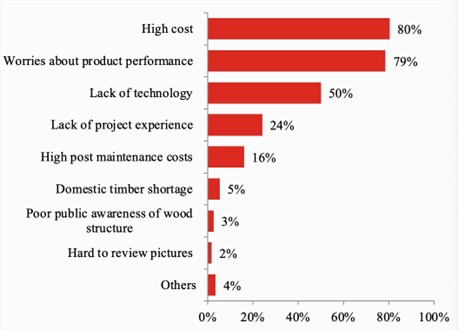Designer Survey Reveals Challenges and Opportunities for Wood Construction in China
Recently, Canada Wood China (CW China) has completed the “China Designer Survey on Recognition of Modern Wood Construction” in collaboration with Reach Construction Consulting Co., Ltd (RCC). RCC is one of the leading consulting firms for project information in the construction and industrial sectors, committed to providing accurate and timely market intelligence and promotional services. It has expanded its network into eleven major cities in China, with significant project coverage across the country.
In the context of China’s “Carbon Peak and Carbon Neutrality Goals” and the promotion of prefabricated wood construction, Canada Wood China worked with RCC to identify market opportunities for modern wood construction in China by interviewing designers. The survey methodology included telephone calls and face-to-face meetings to gather feedback on perceptions of modern wood construction, technical blind spots, problems existing in projects and preferred training and promotion methods. A total 112 interviews were conducted for the final report.
This survey identified areas of interests in wood construction and designers’ preference for the manner that they acquire new information, which is quite useful for Canada Wood China to plan engagement activities to train designers in the future. Through the research, we find that most designers including architects and engineers, no matter if they have experience working on wood projects or not, have an interest in the use of wood in construction. About 90% of those designers that have never worked with wood before expressed an interest to try. They generally agreed that wood has a unique aesthetic perception, and China has a long history of building with wood. They also pointed out some concerns and obstacles while (considering to) using wood construction.
Here are the key findings:
Knowledge of Wood Construction

- 76% have limited or no knowledge of wood construction
Suitability of Wood Construction

- 90% designers think wood construction is suitable for non-residential projects for industries such as Culture, Tourism, Wellness and Elderly Care (CTWE)
- 25% says public buildings
- 18% says commercial buildings
Comments on opportunities for WFC


- In general, benefits of wood construction align with a number of policies such as carbon neutrality, prefabrication, and low-rise housing in county areas. The government has not provided specific construction goals or incentives for wood construction, although there are new policies regarding green building materials that include wood construction, which are not as well known.
- Most designers interviewed have not paid much attention to new policies.
- 59% of designers are optimistic or very optimistic about the development of wood construction in China. Designers with knowledge of wood construction tend to be more optimistic.
Comments on barriers to the development of WFC in China

- High cost and uncertain product performance are the top concerns.
- Designers are not able to provide design details and specifications such as connections for hybrid structures due to lack of technical standards, specifications, or experience.
- Longer design review & approval times, due to incomplete details or specifications, or the drawing reviewers are not familiar with WFC.
- Long review and approval time of local fire authority.
- Lack of recognized engineering calculation software for wood structures
Recommendations
- Case studies, specifications and standards, cost control and material selection are the top 4 categories of technical information wanted by designers.
- 44% preferred online presentation or assisted learning, 29% preferred online + offline, 23% preferred offline.
- Use actual projects to demonstrate designs and solutions.
- Use scaled models to illustrate designs.
- Provide sample designs and layouts for common building types.
- Provide technical training on engineering software
- Develop a localized carbon emission calculator for WFC for China.
- Wood-steel hybrid projects or wood-concrete hybrid projects will have better market opportunities. Training on design of structures and connections are in demand.


